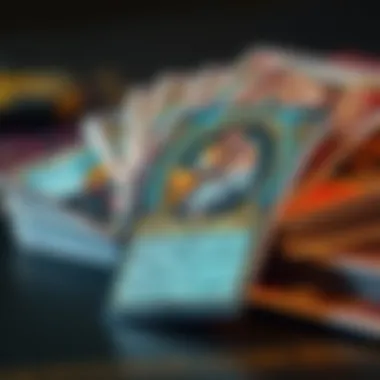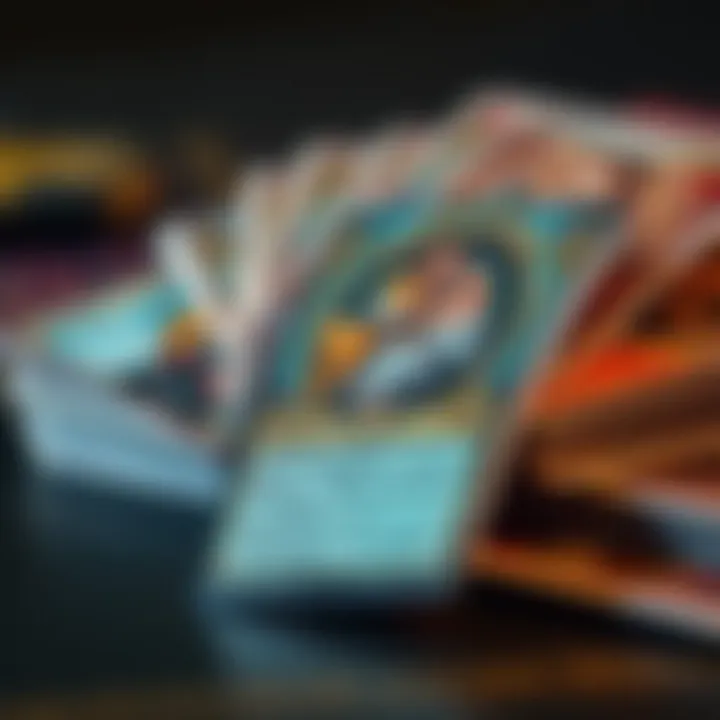Mastering Magic Card Identification Techniques


Intro
In the vibrant landscape of trading card games, one name stands out among the rest: Magic: The Gathering. The age-old quest to identify and appreciate these cards goes beyond mere gameplay; it digs deep into the realms of individual artistry, strategic gameplay, and a passionate community. Recognizing magic cards isn't just a skill for collectors; it's a blend of detective work and artistic appreciation that can truly elevate the experience of engaging with these treasures.
As the popularity of this card game has soared over the years, understanding how to identify different cards has become essential for enthusiastic players and collectors alike. Amidst the numerous expansions and card releases, aspiring aficionados are frequently bombarded with a myriad of options, making it a daunting task to distinguish one card from another. This article seeks to unravel the complexities of identifying magic cards, aiding in the navigation of this intriguing hobby, while simultaneously appreciating the culture steeped in this captivating universe.
Understanding the Basics
Before diving into methods of identification, it’s paramount to grasp what constitutes a magic card. Each card typically displays a unique name, along with specific game mechanics represented through mana costs and abilities. Additionally, the artwork captivates the player's imagination and offers a glimpse into the thematic elements of the card's design.
Getting familiar with card types is another critical aspect. In Magic: The Gathering, players can encounter a variety of card types such as creatures, spells, artifacts, and enchantments, each holding distinct functions in gameplay.
Moreover, every card is categorized by rarity levels: common, uncommon, rare, and mythic rare. The rarity often correlates with the card's value and desirability among collectors.
By navigating through these foundational elements, both new and experienced players can begin to develop the discernment necessary for identifying magic cards effectively.
As we proceed, this guide will unveil necessary strategies, highlight emerging tools, and emphasize community resources that bolster card identification skills.
In the subsequent sections, we will delve into more intricate aspects of card identification, examining trending tools and techniques, alongside insights gleaned from seasoned collectors. Whether your goal is to master gameplay or to curate a personal collection, having a solid handle on the nuances of card identification is fundamental to your journey.
Understanding Magic Cards
Understanding the intricate world of Magic Cards isn't just a pastime; it’s a journey into a universe of strategy, creativity, and community. For fans of trading card games, knowing how to navigate this realm enriches the experience and enhances gameplay. More than just collectibles, these cards hold stories, mechanics, and a unique art form that speaks to many enthusiasts. This exploration will lay out the foundation for appreciating Magic Cards and equip players with insights necessary for effective identification.
Definition and Purpose
Magic Cards, primarily known from the game Magic: The Gathering, are more than mere pieces of cardboard. They are vessels of lore, conduits of strategy, and tools for connection among players. At their core, they serve two main purposes: to facilitate gameplay and offer a medium for storytelling. From creatures and spells to artifacts and lands, each card comes alive with flavor text and art, embodying worlds far beyond our own.
Identifying these cards allows players to wield them effectively in gameplay strategies while also connecting with the narrative they represent. When you know your cards, you can better plan your moves, understanding how to build synergies and counter opponents. Likewise, recognizing their value can transform a casual hobby into a far more engaging and profitable venture.
The Evolution of Magic Cards
The journey of Magic Cards started in 1993, a remarkable year that changed the landscape of gaming forever. Originally, these cards were intended for casual play among friends, yet over time, they evolved into an expansive, competitive phenomenon with millions of players worldwide. Early iterations focused on basic mechanics, but as the game grew, card types, abilities, and artworks became increasingly sophisticated.
One notable advancement was the introduction of expansions, which added layers of complexity and further enriched gameplay. Cards like "Black Lotus" or "Ancestral Recall" quickly became legendary, not only due to their in-game power but also their market value. It paved the way for collectors and investors as much as it did for strategists and casual players.
Today, the landscape is vibrant, with a wide variety of formats and gameplay styles that cater to nearly every type of participant. This evolution reflects the ongoing innovations in game design and cultural trends, where artist collaborations and thematic expansions keep the community engaged and excited. Understanding this history helps players appreciate not only their gameplay mechanics but also the artistry and community behind each card.
"The only constant in Magic is change, and with each new card set, the game refreshes our perception of strategy and creativity."
Overall, grasping the essence of Magic Cards is crucial for any enthusiast. It lays the groundwork for subsequent investigations into their components, rarity, artwork, and overall relevance in the greater trading card ecosystem.
Components of Magic Cards
Understanding the components of Magic cards is essential for anyone looking to enhance their identification skills and appreciation of the craft that goes into these collectibles. Magic cards are more than just pieces of cardboard; they embody intricate designs and gaming mechanics that contribute to the overall player experience. Understanding their components allows collectors and players to delve deeper into gameplay strategies and card valuation.
Card Types and Their Characteristics
Magic cards are categorized into distinct types, each representing different gameplay functions and strategic roles. These types include creatures, sorceries, enchantments, artifacts, and planeswalkers, among others.
- Creatures: These are often at the forefront of any game, serving as the primary means of offense and defense. Each creature card has its own power and toughness, which determines its effectiveness in battle. Take the Serra Angel, for instance; not only can it attack, but it also has a flying ability that can change the dynamics of a game.
- Sorceries: These are one-time spells that create significant effects, like drawing cards or dealing damage. An example is Wrath of God, which can clear the board of creatures. Understanding when to deploy sorceries can turn the tide of a match.
- Enchantments and Artifacts: Both enhance gameplay in unique ways. Enchantments often affect creatures or players, while artifacts can provide mana, draw cards, or grant other abilities. Cards like Black Lotus exemplify how artifacts can create explosive turns.
- Planeswalkers: A relatively modern addition, these cards represent powerful allies. With multiple abilities, each planeswalker has a loyalty score, which is crucial for tactical planning in-game. For example, Liliana of the Veil can be a game-changer due to her versatility.
Understanding the characteristics of these card types not only enriches the gameplay experience but also helps in identifying valuable cards based on their utility and synergistic potential.
Elements of Card Design
The design of Magic cards is a thoughtful blend of art, function, and storytelling. Each element serves to not just beautify the card but also to enhance its strategic role in gameplay.
- Artwork: The visual aspect of a card garners immediate attention and can affect a player's draw to specific cards. For example, the striking illustration of Jace, the Mind Sculptor provides both visual appeal and hints at its complex gaming implications. The art can also reflect themes that resonate with the game’s lore.
- Card Text: Typically categorized into abilities and flavor text, the language used can convey crucial information about how to play the card. Clear and concise wording ensures players understand how each card contributes to gameplay. A card like Counterspell is not just a cool concept; its text clearly states its function, allowing players to utilize it effectively.
- Color Identity: Each Magic card belongs to a color that represents certain themes and mechanics—red stands for aggression, while blue often revolves around control and manipulation. Recognizing a card’s color can give insights into its role within a deck composition.
- Set Icons and Rarity Symbols: These indicate the card's expansion origins and relative scarcity, informing collectors and players alike about potential value. Understanding how to interpret these symbols can be essential for savvy trading and collection management.


In summary, grasping the details of card types and design features equips players and collectors with valuable insights for identification, analysis, and eventual valuation of cards. The components of Magic cards form the backbone of both gameplay and collecting, making them an indispensable part of the Magic community.
Identifying Card Rarity
Identifying card rarity is vital in the world of trading card games, particularly for enthusiasts and collectors. The rarity of a card isn’t just a number; it's a significant factor that influences desirability and market value. When you understand how to determine a card's rarity, you unlock insights into its potential worth and its place within the game's hierarchy. In this section, we will delve deep into the concept of rarity levels, and how market values fluctuate based on these designations.
Understanding Rarity Levels
Rarity levels are classifications that dictate how common or rare a card is in circulation. These can range from common cards, which flood the market, to ultra-rare cards that few lucky individuals might possess. Here’s how it typically breaks down:
- Common Cards: Easily found and often abundant in packs. You could buy a dozen booster packs and see the same common card pop up repeatedly.
- Uncommon Cards: Slightly rare than common cards but still fairly easy to come by. They are often the backbone of many decks, adding both functionality and style.
- Rare Cards: Scarcer than the others, often featuring unique mechanics or powerful effects that can change gameplay dynamics. Many collectors seek these out to complete their decks or merely for their aesthetic appeal.
- Mythic Rares: A cut above rare cards, these are sought-after gems. Holding a mythic rare can feel like holding a golden ticket, as they often provide high value not just in gameplay but also in the market.
- Promo Cards: These may not fit neatly into the rarity categories above but are often distributed during events or as special promotions, sometimes making them highly coveted based on the event's significance.
Understanding these levels is essential because it helps collectors navigate the vast sea of cards out there. A clear grasp of rarity levels not only amplifies enthusiasm but also bolsters investment strategies.
Assessing Market Value
Market value is not merely a reflection of a card's rarity; it’s shaped by several other factors including demand, playability, and even nostalgia. Evaluating a card’s worth requires a nuanced approach. Here are some key considerations:
- Supply and Demand: A card might be rare, but if no one wants it, its value may dwindle. Conversely, a recently popular card can command high prices despite being less rare.
- Condition: A card's condition plays a significant role in determining its market price. A mint condition card can fetch a premium, whereas a heavily worn card could be worth pennies on the dollar.
- Timing: The market can be volatile. Prices might surge after a significant tournament where a particular card performs well. Keeping a pulse on the game’s meta is crucial for collectors and players alike.
- Collector Sentiment: Sometimes, a card's value can skyrocket due to fanfare surrounding an artist, a popular character, or even a nostalgic connection. This emotional investment can sometimes outweigh the actual rarity.
- Resources: Utilize platforms like TCGPlayer or eBay for current pricing trends, and engage in discussions on places like Reddit for insights from fellow players.
"Rarity, alongside condition and market trends, crafts the landscape of a card's value in the world of collecting."
In sum, recognizing a card's rarity and understanding its market value represent crucial steps for collectors and players aiming to enhance their card portfolios. As the market evolves, so too does the dynamic of rarity—keeping alert to shifts will serve enthusiasts and collectors well, often leading to fruitful investments and enhanced gameplay experiences.
Identifying Cards Through Artwork
Artwork plays a vital role in identifying magic cards, and the significance of this aspect cannot be overstated. Each card's artwork is not merely a visual component; it's a narrative, a glimpse into the lore that enriches the game. Different card frames and art styles evoke distinct feelings among players and collectors, which often makes identifying them through this visual language both an art and a science.
Analyzing Artistic Styles
When it comes to magic cards, the artistic styles are as varied as the cards themselves. Artists bring their unique flair and technique to the cards, creating a diverse array of images that can evoke different emotions and even hint at a card's function within gameplay.
- Illustration Techniques: Some cards may use traditional painting techniques, while others might showcase digital artistry or even collage. These variations in medium can often signal the time period or the set from which the card hails.
- Color Palette: The choice of colors can heavily influence how a card is perceived. For instance, cards draped in darker shades may suggest a foreboding power, whereas vibrant hues can signify joy and vigor. Notably, analyzing the color scheme alongside the imagery gives vital clues.
- Symbolism and Themes: Many artists embed deeper meanings in their illustrations. Occasionally, card art might feature specific creatures, lands, or characters that are pivotal to the game’s lore. Familiarizing oneself with these recurring symbols can provide contextual clues essential for identification.
By considering these artistic elements, one not only begins to grasp the aesthetics behind the cards but also gathers a deeper understanding of the mechanics they may represent.
Importance of Artist Signatures
Artist signatures can be a gold mine for identifying cards. These small but crucial elements often determine a card's value and authenticity. A signature from a notable artist can increase a card's desirability. Recognizing the following factors highlights their importance:
- Authorship Recognition: Knowing the artist who created the work not only enhances its narrative significance but also places the card within a broader context of the artist's body of work. Some artists have unique styles that are easily recognizable.
- Scarcity and Signature Variants: Sometimes, an artist will sign in different ways or use variations across different sets. Identifying these nuances can significantly aid in discerning a card’s lineage and value. For example, a card that bears a particular symbol or altered signature may represent a limited run.
- Market Trends: Certain artists gain traction over time, making their signed cards more sought after. Keeping up with market demand for specific artist signatures can streamline the identification process, reinforcing the card's value and collectability.
"A well-signed card isn’t just an aesthetic preference; it’s a breadcrumb leading to its historical significance and monetary value."
The nuances of artistic styles and signatures collectively enhance the magic card identification experience. Understanding these elements can improve one's appreciation for both the artwork and the game, enhancing both gameplay and collecting.
Digital Tools for Card Identification
Identifying magic cards has undergone a significant transformation with the advent of digital tools. In an age where technology permeates every aspect of our lives, collectors and enthusiasts are no longer confined to traditional methods of identification. Digital tools not only streamline the identification process but also enhance the overall experience of collecting. They enable users to access vast amounts of information quickly and efficiently, significantly reducing the time spent searching for cards.
With the right resources at their fingertips, collectors can delve into past expansions, variants, and rarities without flipping through stacks of physical cards or endless catalogs. This section will explore two primary avenues: mobile apps that provide seamless scanning capabilities and online databases that serve as exhaustive repositories of card information.
Utilizing Mobile Apps
Mobile apps have become indispensable for collectors, catering to the need for instant identification. Most of these apps are designed with user-friendliness in mind, making it easy even for newcomers to navigate. For instance, Cardmarket and MTG Assistant can scan a card’s image or read the text using Optical Character Recognition (OCR) technology.
This real-time identification allows collectors to access data about the card’s rarity, price trends, and even details like its flavor text—all from their smartphones. A few benefits of using mobile apps include:
- Quick Scanning: Users can quickly identify cards by simply taking a photo, saving time and effort on manual searches.
- Up-to-date Market Data: Many apps provide current market prices and historical trends, helping collectors gauge the value of their cards accurately.
- User-Friendly Interfaces: With intuitive designs, even novice collectors can leverage these tools with little to no learning curve.


However, while mobile apps offer a plethora of advantages, there are some limitations to consider. Not every app covers all editions or special prints, and occasionally, image recognition might misidentify poorly lit or damaged cards. Hence, it is prudent to cross-check findings using complementary resources.
Online Databases and Resources
Online databases play a vital role in the broader landscape of card identification. Websites like Scryfall and Gatherer serve as extensive databases where users can search for cards based on multiple criteria, including name, mana cost, and card type. These platforms aggregate information from thousands of cards and expansions, presenting it in a user-friendly manner that simplifies research considerably.
Some notable features of online databases include:
- Search Filters: Fine-tune searches according to color, set, or even card text, enabling users to narrow down vast collections to find specific cards.
- Visual References: High-quality images allow users to visually confirm cards' authenticity and design variations.
- Community Contributions: Many databases have active communities that share insights and updates, offering an added layer of depth and knowledge.
Nonetheless, while online databases are comprehensive, they rely on user engagement to maintain the currency of their content. Occasionally, you might stumble upon outdated information or missing cards, especially from less popular sets. Thus, it’s essential to remain vigilant and continuously seek out the most reputable sources to ensure accurate identification.
Community Knowledge and Resources
The world of magic cards is vast and intricate, and navigating through its endless details can sometimes feel like trying to find a needle in a haystack. This is where leveraging community knowledge and resources becomes invaluable. Engaging with fellow collectors and enthusiasts not only elevates one’s expertise but also fosters a sense of belonging within a niche community. Let’s delve deeper into this essential aspect, examining how it benefits the card identification process and enhances the overall experience.
Engaging with Collector Communities
One of the most powerful tools in card identification is the collective wisdom of collector communities. These groups often gather on various platforms, such as Reddit, Facebook, or dedicated forums, where they share insights, tips, and experiences related to magic cards. Joining these communities is like being handed a treasure map; you gain access to hidden gems of knowledge that can simplify identifying rare cards or understanding the latest market trends.
- Shared Experiences: When collectors discuss their challenges in identifying cards, they often reveal techniques or approaches that might be overlooked by solo enthusiasts. Real-world anecdotes about spotting counterfeits or identifying misprints can be incredibly enlightening.
- Mentorship Opportunities: Many seasoned collectors are ready to offer guidance to novices. This mentorship can include everything from advice on valuation to methods for authenticating rare cards based on subtle details that may not be immediately obvious to a newcomer.
- Event Participation: Many collector communities organize meetups or events like trading sessions or card shows, which provide an excellent opportunity for members to share their knowledge in person. You get to learn about cards while surrounded by individuals who share your passion.
Forums and Social Media Platforms
Forums and social media serve as lively hubs for card enthusiasts, allowing for a bubbling exchange of ideas, questions, and resources. Here, anyone from casual collectors to die-hard fans come together to discuss various aspects of their beloved hobby.
- Diverse Perspectives: Each member brings their unique background and viewpoints, enriching the discussion and allowing for a broader understanding of the nuances involved in identifying cards.
- Real-Time Information: With the ever-changing landscape of magic cards—from new releases to current market trends—social media allows collectors to stay up-to-date with the latest developments, news, and tips as they happen. This immediacy can be crucial for those looking to make informed purchases.
- Problem Solving: Have a tricky card in your hand and unsure of its origin or value? Posting a clear image and description in a relevant forum often leads to quick, helpful responses from knowledgeable members who can shed light on your query.
Engaging actively with these communities and platforms nurtures not just personal growth in the realm of card identification but also a deep-rooted camaraderie amongst enthusiasts, creating lasting friendships along the way. In the end, tapping into community knowledge and resources is a passing key that opens doors to a richer experience of magic card collecting and identifying.
Deciphering Gameplay Mechanics
Understanding gameplay mechanics is core to appreciating and identifying Magic Cards. These mechanics dictate how cards interact during the game. Properly recognizing these elements can enhance one's gameplay strategy and overall experience in the world of trading cards.
Gameplay mechanics can be complex, as they vary across different editions and expansions. Knowing how to decipher them allows players to execute strategies effectively. For instance, consider the concept of mana costs. Different cards require specific amounts of mana to cast, and mastering how to manage your resources can often mean the difference between victory and defeat. A well-timed spell can swing a game dramatically, but without understanding the implications of mana costs, such spells may remain stuck in your hand.
Understanding Game Effects
Game effects refer to the actions completed when a card is played. Each card can have simple or intricate effects that can alter the course of the game. These effects can be broken down into several categories:
- Instant Effects: These are effects that occur immediately and can surprise opponents.
- Triggered Abilities: Such effects activate under specific conditions and can catch players off guard when they’re not aware.
- Continuous Effects: These effects remain in play, creating ongoing advantages or disadvantages.
Recognizing these nuances is essential for players aiming to maximize their card efficiency. An example could be a card that says "whenever you cast a spell, draw a card." Understanding how often to use such cards in combination with others can create formidable strategies that leverage card draw to one's favor.
Recognizing Card Synergies
Synergy in gameplay refers to the way specific cards work together to create a greater effect than the sum of their individual parts. Knowing how to combine cards can elevate a player's strategy from basic to tactical complexity. Consider this example: a card that boosts the attack power of all creatures on the field. Pairing this with creatures that have low cost and can be summoned rapidly creates a lethal combination that can overwhelm an opponent in one turn.
In order to identify card synergies successfully, players should:
- Study Most Common Pairings: Familiarize yourself with popular decks and commonly used combos. This can often be found in player forums or discussions on sites like reddit.com.
- Experiment with Unlikely Combinations: Just because a pairing isn’t widely recognized doesn’t mean it won’t work well. Unique strategies can often catch opponents off-guard.
- Observe Tournament Play: Pay attention to decks used by top players. This can provide clues to synergies that may not be immediately obvious.
Preservation and Care of Magic Cards
Preservation and care of Magic cards is not merely a choice; it’s an imperative for every collector who wants to maintain the integrity and value of their collection. As any seasoned collector would tell you, the landscapes of trading card games are rife with potential hazards. Whether it’s a casual game at a friend’s house or the dusty shelves of a storage unit, the threats to your treasured cards are relentless. From spills to scrapes, these elements can irreparably damage cards, diminishing both their gameplay effectiveness and market value. Hence, understanding how to properly care for and preserve these cards ensures they remain in optimal condition for years to come.
Proper Storage Solutions
Storing your Magic cards is more than simply tossing them in a drawer or a box. You must consider temperature, humidity, and light exposure. Heat and moisture are the nemeses of card integrity; they can warp or discolor even the rarest cards. Here are some effective storage solutions to keep in mind:


- Card Sleeves: These are your first line of defense. Investing in high-quality, clear sleeves protects against dust, fingerprints, and minor abrasions. Sleeves are available in various material qualities, so aim for sturdy types that resist tearing.
- Toploaders: For valuable cards, top loaders offer extra protection. These rigid plastic holders prevent bending or creasing, making them ideal for high-value pieces.
- Binders: Using a dedicated binder with protective sheets allows for safe storage while making it easy to display your cards. Opt for binders with sleeves that don't contain PVC, as it can damage cards over time.
- Climate-Controlled Storage Boxes: If you have a large collection, consider a climate-controlled environment. These boxes can shield against extreme heat and moisture that normal basement or attic storage might expose your cards to.
“Proper storage isn’t just about keeping your cards; it’s about honoring the passion behind the collection.”
Handling and Maintenance Tips
Handling your Magic cards with care can mean the difference between a card’s lifespan and its demise. While it may seem innocuous, each interaction with a card can introduce risks if not done thoughtfully. Here are some tips for proper handling and maintenance:
- Clean Hands: Always handle cards with clean hands. This prevents the transfer of oils from your skin, which can lead to damage over time. Consider using cotton gloves when handling particularly valuable cards.
- Avoid Eating or Drinking: It’s wise to keep snacks and beverages far from your playing area. Accidental spills can spell disaster, especially for cards that are not protected by sleeves.
- Store Vertically: When storing cards in boxes or binders, keep them upright rather than flat. Stacking cards can cause bending, especially if weight is applied over time.
- Regular Checks: Periodically review your collection for signs of wear or damage. Early detection of issues like curling or fading allows for prompt intervention, preserving the card’s value.
Caring for Magic cards is an investment in your enjoyment and the preservation of a rich gaming heritage. Each card carries history and value, both monetary and sentimental, making it worth the effort to protect and maintain.
For further insights into preserving your collection, check resources on card care at Wikipedia or engage with the community on Reddit.
Challenges in Card Identification
In the realm of magic cards, navigating through the nuances of identification is akin to traversing a labyrinth. For both novices and seasoned collectors, the challenges associated with this task can make or break one’s experience in collecting and trading. This section aims to shed light on these challenges, emphasizing not only their significance but also providing strategies to overcome them.
Understanding these challenges is essential for collectors looking to preserve their investments and engage more meaningfully with the game. The excitement in recognizing a rare card can be overshadowed by the lurking threats of forgeries and misprints. Thus, being well-versed in these challenge areas contributes greatly to informed decision-making.
Dealing with Counterfeits
Counterfeits, unfortunately, have become a persistent issue within the trading card community. These fakes often look convincing to the untrained eye, with many replicating the artwork and even card texture. A collector might walk into a trading hall, excited to trade or purchase, only to find they’ve bought a counterfeit card masquerading as the real deal.
To tackle this headache, collectors should sharpen their skills in identification techniques. Below are several tips to help minimize the risks associated with counterfeit cards:
- Visual Inspection: Pay attention to artistic details. Genuine magic cards often have specific nuances in artwork that counterfeits might overlook.
- Card Stock and Feel: The texture is also telling. Authentic cards have a particular weight and can feel different against the light.
- Use of Tools: Magnifying glasses or even a good smartphone camera can reveal imperfections in printing, helping to authenticate a card’s legitimacy. Also, there are applications like 'CardSmith' or 'TCGPlayer' that can assist in identifying genuine cards.
Ultimately, being vigilant and informed is crucial in evading counterfeits. The last thing you want is to be caught holding the proverbial bag of tricks.
Identifying Misprints and Variants
Misprints and variant cards, while often considered collectible gems, can also present significant challenges when it comes to identification. Such cards can vary from minor printing errors to complete artwork shifts, with some becoming highly valued for their uniqueness. Collectors may cherish these variations, not just for their potential worth but also for their rarity.
However, identifying these misprints doesn’t come easy. It often requires a keen eye and a solid understanding of what differentiates a true misprint from a mere mistake. Here are some points to consider:
- Research: Familiarize yourself with distribution patterns. Some misprints are more common than others. For instance, a misprint in the Alpha Edition has different characteristics than one from the Mystery Booster.
- Community Insight: Engaging with forums and groups, such as those on Reddit or specialized Facebook pages, can provide valuable intel on what to look for.
- Comparison: Side-by-side comparisons with verified cards can spotlight the differences. If you have access to a known legitimate card, it’s easier to point out variations.
Understanding these misprints can not only enhance your collection but also tie into its story—making every card hold a piece of history, floating between the lines of artistry and printing.
"In the world of collections, recognizing what makes a card unique enriches the experience far beyond mere numbers and values."
Future Trends in Magic Card Collecting
The world of magic card collecting is continuously evolving, driven by technological advancements and shifting consumer preferences. In recent years, trends have emerged that not only change how collectors engage with their cards but also how these collectibles fit into the broader cultural landscape. Understanding these trends is crucial for enthusiasts looking to stay relevant in a dynamic market. The importance of grasping future trends lies in several key elements, including the integration of digital tools, the rise of virtual markets, and the changing ways collectors nurture their passions.
Impact of Digital Collecting
Digital collecting has taken the realm of card gaming by storm. Platforms like Magic: The Gathering Arena and various mobile applications have enabled players to collect, trade, and compete without needing physical cards. For many collectors, this shift means ease of access and a broader audience. The convenience of managing a collection digitally eliminates the worries associated with storage and handling.
- Advantages of Digital Collecting:
- Ease of Access: Instant access to a vast library of cards.
- Lower Costs: Digital versions often circumvent printing costs, making them more affordable.
- Community Engagement: Online platforms facilitate vibrant community interactions, creating a sense of belonging.
However, there are also cautionary tales. Collectors must keep an eye on how digital platforms operate, the potential for data breaches, and the fleeting nature of digital ownership. The ability to sell or trade digital assets may not offer the same satisfaction as physically handling a prized card. As more gamers move toward digital realms, the question becomes: does the thrill of collecting diminish when cards are just a click away?
Changing Market Dynamics
The market dynamics of magic card collecting are shifting due to various factors. Economic fluctuations can impact the trading card game's landscape. With the rise of new collectors during events like the pandemic, there's a noticeable increase in demand for both new and vintage cards. Collectors are now navigating a landscape where prices are often determined not just by a card's rarity but also by its context in pop culture.
- Current Trends in Market Dynamics:
- Increased Interest from Younger Generations: Young players are drawn to nostalgic IPs, often driving up prices for cards tied to their favorite franchises.
- Globalization of the Market: As collectors worldwide embrace magic cards, card values may fluctuate based on regional interests. A card highly valued in North America may find a lower price point in Asia, and vice versa.
- Accessibility of Information: Internet-based resources and community forums facilitate real-time information sharing about market trends, actively influencing buyer behavior.
"When the landscape shifts, collectors need to pivot quickly—those who adapt will thrive."



